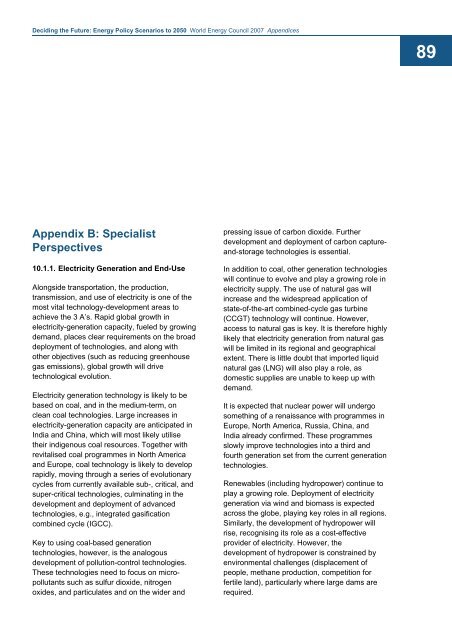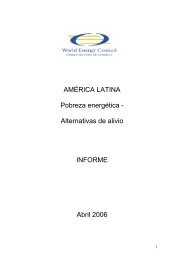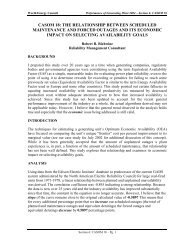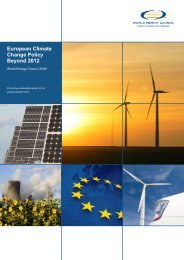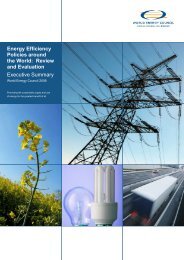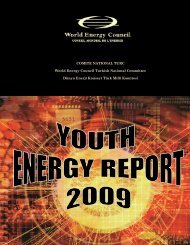Deciding the Future: Energy Policy Scenarios to 2050
Deciding the Future: Energy Policy Scenarios to 2050
Deciding the Future: Energy Policy Scenarios to 2050
You also want an ePaper? Increase the reach of your titles
YUMPU automatically turns print PDFs into web optimized ePapers that Google loves.
<strong>Deciding</strong> <strong>the</strong> <strong>Future</strong>: <strong>Energy</strong> <strong>Policy</strong> <strong>Scenarios</strong> <strong>to</strong> <strong>2050</strong> World <strong>Energy</strong> Council 2007 Appendices<br />
89<br />
Appendix B: Specialist<br />
Perspectives<br />
10.1.1. Electricity Generation and End-Use<br />
Alongside transportation, <strong>the</strong> production,<br />
transmission, and use of electricity is one of <strong>the</strong><br />
most vital technology-development areas <strong>to</strong><br />
achieve <strong>the</strong> 3 A’s. Rapid global growth in<br />
electricity-generation capacity, fueled by growing<br />
demand, places clear requirements on <strong>the</strong> broad<br />
deployment of technologies, and along with<br />
o<strong>the</strong>r objectives (such as reducing greenhouse<br />
gas emissions), global growth will drive<br />
technological evolution.<br />
Electricity generation technology is likely <strong>to</strong> be<br />
based on coal, and in <strong>the</strong> medium-term, on<br />
clean coal technologies. Large increases in<br />
electricity-generation capacity are anticipated in<br />
India and China, which will most likely utilise<br />
<strong>the</strong>ir indigenous coal resources. Toge<strong>the</strong>r with<br />
revitalised coal programmes in North America<br />
and Europe, coal technology is likely <strong>to</strong> develop<br />
rapidly, moving through a series of evolutionary<br />
cycles from currently available sub-, critical, and<br />
super-critical technologies, culminating in <strong>the</strong><br />
development and deployment of advanced<br />
technologies, e.g., integrated gasification<br />
combined cycle (IGCC).<br />
Key <strong>to</strong> using coal-based generation<br />
technologies, however, is <strong>the</strong> analogous<br />
development of pollution-control technologies.<br />
These technologies need <strong>to</strong> focus on micropollutants<br />
such as sulfur dioxide, nitrogen<br />
oxides, and particulates and on <strong>the</strong> wider and<br />
pressing issue of carbon dioxide. Fur<strong>the</strong>r<br />
development and deployment of carbon captureand-s<strong>to</strong>rage<br />
technologies is essential.<br />
In addition <strong>to</strong> coal, o<strong>the</strong>r generation technologies<br />
will continue <strong>to</strong> evolve and play a growing role in<br />
electricity supply. The use of natural gas will<br />
increase and <strong>the</strong> widespread application of<br />
state-of-<strong>the</strong>-art combined-cycle gas turbine<br />
(CCGT) technology will continue. However,<br />
access <strong>to</strong> natural gas is key. It is <strong>the</strong>refore highly<br />
likely that electricity generation from natural gas<br />
will be limited in its regional and geographical<br />
extent. There is little doubt that imported liquid<br />
natural gas (LNG) will also play a role, as<br />
domestic supplies are unable <strong>to</strong> keep up with<br />
demand.<br />
It is expected that nuclear power will undergo<br />
something of a renaissance with programmes in<br />
Europe, North America, Russia, China, and<br />
India already confirmed. These programmes<br />
slowly improve technologies in<strong>to</strong> a third and<br />
fourth generation set from <strong>the</strong> current generation<br />
technologies.<br />
Renewables (including hydropower) continue <strong>to</strong><br />
play a growing role. Deployment of electricity<br />
generation via wind and biomass is expected<br />
across <strong>the</strong> globe, playing key roles in all regions.<br />
Similarly, <strong>the</strong> development of hydropower will<br />
rise, recognising its role as a cost-effective<br />
provider of electricity. However, <strong>the</strong><br />
development of hydropower is constrained by<br />
environmental challenges (displacement of<br />
people, methane production, competition for<br />
fertile land), particularly where large dams are<br />
required.


